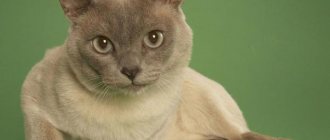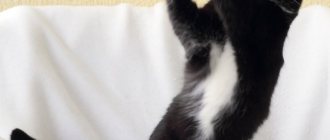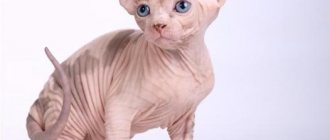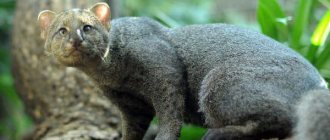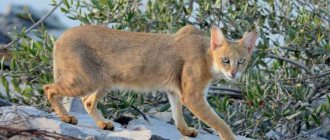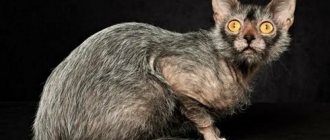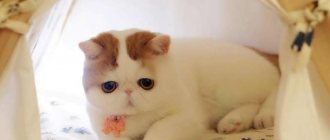A cat is like a leopard, it is also a Bengal or Asian - smart, curious and very active. He is constantly on the move, loves to climb higher, plays a lot and easily learns to walk on a leash.
What makes cats absolutely happy is access to free range and the opportunity to exercise their hunting instinct. Bengals are able to catch fish if there is an aquarium in the house. They won’t refuse to take a shower or swim in the bath. By nature, kitties crave constant attention, therefore, if there is a person in the family who often stays at home, then the pet will enjoy the company of the owner.
Asian leopard cat in nature
The Asian wild cat lives in Southeast Asia and the Far East.
Habitat: tropical forests, undergrowth, coniferous and deciduous forests, river valleys. Wild cats “consider” their territory to be 2-3 km2. They mark her with excrement. They make their dens in hollows or burrows left by other animals. Often one predator has two shelters.
Leopard cats can swim and sometimes catch fish and crayfish. They usually hunt small rodents, birds, lizards, and large insects. They can destroy bird nests.
There are several subspecies of the Asian leopard cat:
- Bengali;
- Chinese;
- Himalayan;
- Far Eastern.
There are 20 subspecies in total. Most of them are listed in the Red Book and are on the verge of extinction.
Where does the wild leopard cat live?
Wild representatives of the leopard cat are found in Russia in the Amur region. The breed is quite common in China, except in the western regions; in India the situation is the opposite - there the animals have not taken root in the southern part of the country. The cat has long settled in Indonesia and the Philippines, but not a single specimen has been spotted in Australia. This breed prefers evergreen subtropics low above sea level. In the harsh conditions of Russia and northern China, it chooses fertile forest valleys near rivers. At the same time, the habitat extends only to those areas where snow cover in winter does not exceed 10–12 centimeters. Each animal has its own territory, sometimes it reaches 20 square meters. km.
Description of the species
The Asian cat is slightly larger than domestic cats. Sizes depend on area:
- Weight 5-7 kg, body length 45 cm (Indonesia).
- Weight 17-10 kg, body length 60 cm (Far East).
- Weight 2-3.8 kg, body length 39 cm (northwestern regions of China).
Height is about 40 cm. Males of this species are larger than cats. In winter, male Amur leopard cats can gain weight up to 15 kg.
The body of miniature predators is elongated, the tail is long from 17 to 20 cm. As a percentage, it makes up 50% of the body length. In representatives of the species living in the vast expanses of the Ussuri taiga, it can reach 40 cm.
The legs are long and muscular. The forelimbs are slightly shorter than the hind limbs. Thanks to this, the Asian leopard cat can perfectly jump around villages and pursue its prey for a long time. There are small membranes on the paws, due to this, predators swim well and move easily on slippery ground or grass.
The following exterior features are distinguished:
- The head is narrow and short. The nose is large, the lobe is slightly forked. In color it can be either pink or brick. Lips black.
- The ears are a rich brown hue, rounded at the ends, with a white mark on the outside. Its felinology is called a wild spot.
- The eyes are large, round, brown or golden, amber, yellow. Rarely do “northern” cats have a gray-blue tint. There are small white spots on the fur under the eyes.
The fashion has dark stripes running from the eyes to the ears. And there are white spots near the mouth. The mustache is also light.
Description of the breed
This species appeared in 1963 in America, thanks to the crossing of an ordinary cat with a leopard, hence the characteristic spotted color of the breed. It was the color that played its role in the popularization of these cats throughout the world. Many people want to get an exotic animal right at home, but they don’t always have the courage and basic space.
The Bengal cat is an ideal option in this sense, if not for its small size, it would be easy to confuse such an animal with a wild inhabitant of the savannah. Experts note several features of this breed:
- “Bengals” are very attached to the place and people with whom they are for a long time.
- The cat's friendliness and playfulness make it an ideal gift for children.
- It is quite easy to care for her, considering that she is a cross between a leopard and a cat, she has independence and a free character.
The characteristics of this breed are very noticeable. Firstly, the head is wedge-shaped and the placement of the ears is slightly different from what we are used to. There is an opinion that these animals are aggressive due to their origin, but this is not so. They have only 15–20% of leopard genes, and they are mainly reflected in the appearance of the animal. Also, unlike their counterparts, these spotted ones adore water.
Coat and color
Asian leopard cats are shorthaired. The fur is thick, the guard hairs are soft. The color will depend on the habitat:
- Animals living in the southern regions of their range have a yellowish base coat color. The spots on the fur are dark brown, almost black. They are shaped like rosettes or brush strokes.
- The inhabitants of the Ussuri taiga and northwestern China have a grayish base fur color. The spots are lighter, red-brown in color. They are shaped like horizontally elongated circles. The ancient Chinese called the animals coin cats for their similar color. The spots on their skin resembled the coins then in circulation.
Regardless of the region where they live, stripes and spots are located the same way across a cat’s body. The fur on the belly and chest is white or cream. There are horizontal dark stripes running along them, of medium thickness. On the back, small spots merge into lines or chains. Starting from the middle of the tail, there are light ring stripes towards its tip. The tip of the tail is always black. The largest spots are unevenly colored, their edges are darker than the middle.
Puberty and reproduction
The Asian leopard cat enters sexual maturity at the age of one year, less often at one and a half years. Reproduction of this species occurs regardless of the time of year, with the exception of the northern regions - where natural conditions allow offspring to emerge only in the spring.
Males help females care for their kittens and remain nearby throughout their growing years.
The gestation period for Asian cats is 9 weeks, with a litter of 3 kittens. The kittens begin to see their sight on the 12th day and do not leave the den for a month, feeding on their mother’s milk. At one month, the kittens already taste meat and can leave the den, during which the female and male teach their kittens to hunt and get their own food.
At 10 months, young Asian cats leave their parents and continue to lead an independent life in the wild.
Character
The Asian leopard cat is cautious and shy. In the wild, it never attacks first, preferring reliable shelters to open confrontation. Animals are masters of camouflage; they are difficult to see in thickets of bushes or tall grass.
In the wild, predators prefer to live alone. They form pairs only for reproduction. The cat lives with the kittens for about a year.
Domesticated animals get along well with members of their own species. They get along with domestic cats. Asian cats are cold towards dogs. Hamsters, decorative rats, guinea pigs, and parrots are perceived by animals as prey.
The leopard cat singles out one owner for itself, to whom it is attached. She gets along with other family members too. But he doesn't like strangers. The domestic predator rarely shows aggression towards strangers, preferring to hide from them.
Tamed cats and cats are very smart. They are easy to train. In childhood and adolescence, animals are playful and playful. They can run around the house for a long time, hunting for any small objects in sight.
Asians are nocturnal predators. Even living together with a person, they do not change their habits. The owners will have to adapt.
Animals require attention, otherwise their character and behavior deteriorate. They run wild and behave warily towards their owner. They may perceive his actions as a threat and defend themselves.
Despite their predatory nature, leopard cats and cats do not tolerate stress well. Moving and a tense situation in the house have an extremely bad effect on them. Nervous animals can get sick.
The history of the appearance of the leopard cat breed
The Asian cat is the only positive example of crossbreeding between wild and domestic cats. The first attempts were made back in the 60s of the last century. Official sources first mentioned the Asian cat in the early 1970s. Immunologist William Centerwall studied the immunity of Asian leopards to leukemia, a common disease among felines. He hoped to identify the gene responsible for the development of the disease by crossing wild representatives with domestic ones. After receiving the results and closing the experiments, Centerwall had to get rid of the animals obtained during the experiments. The scientist decided to abandon the generally accepted rule and gave the cats to Jean Sajen.
The woman was an ardent lover of pets, and in the 40s she actively experimented with crossing different breeds at the Department of Genetics. She enthusiastically accepted Centerwall's offer to continue her study and try to breed a completely new hybrid of wild and domestic cats. Only those individuals that were friendly to people, were domesticated, and had a pronounced spotted leopard color were brought into Jean's house. The experiments could end in nothing, the males in the litters turned out to be infertile, so the continuation of the same family was impossible.
For a long time, Sajen was looking for a suitable pet cat. Luck accidentally smiled on her when in one of the zoos she found a street cat with a color similar to that of a leopard print. It was he who laid the foundation for the breed. The first three generations were aggressive and had wild hunting instincts. After the appearance of the fourth generation, breeders noted dramatic changes in character. These animals were fully adapted for living at home. But still not all international organizations have recognized the wild leopard cat breed.
Content Features
Kittens, tamed from early childhood, can live with humans. Animals older than three months of age are practically not amenable to domestication.
If you do not plan to breed an Asian leopard cat, kittens should be neutered before puberty. It is optimal to do this at 5-7 months. In mature, uncastrated animals, the character changes for the worse. They become poorly managed.
Leopard cats are active and need space and the opportunity to play. You cannot keep your pet locked up. This will have a bad effect on the physical and mental health of the predator.
Asians living in apartments need to be walked just like dogs. In winter, animals will need special clothing for walking. Their coat is not adapted to cold weather.
On average, leopard cats should spend 6 hours on physical activity and play. It is better to have two pets at once. This will save the owner’s time on entertaining the domestic predator.
Is it profitable to breed cats?
The Asian leopard breed is becoming increasingly popular. In the modern world, the demand for exclusive breeds is growing. Today there is more supply on the market than demand. This situation changes every year, so breeding Asians for sale is profitable. But it is necessary to closely monitor the development of individuals in order to prevent accidental mating.
This breed will bring into the house not only exoticism, but also a sea of affection. This friendly, playful animal will perfectly cope with the role of a playmate and devoted pet.
The necessary conditions
It is optimal to keep predators in spacious enclosures. Their minimum size is 2x2 meters. The size of the cells in the mesh enclosing the enclosure is from 15x15 to 50x50mm.
The floor is made of wood or concrete. If the size allows, make mounds of earth. Grass, oats, and clover are planted on them. It is worth installing a small pool in the center of the enclosure. Animals love water and willingly splash in it.
They do not make all-glass enclosures for the Asian leopard cat. In the summer heat, the animal overheats in such an enclosure, and there is a high risk of heat stroke.
The pet needs to make two lairs. Their role can be played by wooden booths inside, which are laid with straw or rags.
To simplify cleaning, a tray with sand or sawdust is installed in the barrier. It will serve as a toilet for the cat.
If the size of the enclosure allows, several tree cuts are installed in it. They are placed both vertically and horizontally. Special shelves and bridges will help to ensure climbing activity for leopard cats.
In large enclosures more than 5 meters high, special wooden or stone terraces are made. They are placed on the back wall.
In cold weather, the animal must be moved to a heated and bright room. It should be quite spacious, with an air temperature of at least 20°C.
The animal needs to be provided with physical activity. Regular games will help prevent physical inactivity and obesity. Provide your pet with toys, balls, artificial mice, and birds. Pieces of fabric rolled into bundles or thick ropes will do.
Life in captivity
A spacious enclosure is being prepared for the Asian leopard cat, which has not been raised by humans and has retained its wild habits. Its height is at least 2 m, length 4–5 m. The metal mesh roof is half covered with rainproof material. Two dens are arranged under it so that the animal can choose where to be. They are made in the shape of a sleeve or a house. Wooden parts are used for manufacturing.
Bushes and palm trees are planted inside the enclosure. It is better to equip a pond with a fountain in the center, decorating it with large shellfish shells. 5–8 shelves and bridges are attached to the sides of the enclosure at a height of 0.3–0.6 m from each other. One bed should be fully illuminated by the sun. Sawn logs are installed at an angle or placed on the floor. They add an imitation of rocky terrain and one or two ladders. Covered litter trays are installed in all corners of the enclosure so that the animal can mark its territory.
For physical health, savages organize hunting with feeding of live prey. To do this, cover the side walls of the enclosure with triplex at a height of up to 35 cm from the floor and install a door. They release a rodent. The cat will not only run around to its heart's content, but will also receive moral pleasure.
When keeping one animal at home, at least 6 hours of play time is required daily. Otherwise, boredom will cause your pet’s behavior to deteriorate. It is ideal to foster two Asian leopard cat . This is the best way to keep them active and occupied. Even constantly adding new toys will not cope with this task. If good conditions are created for the animals, the life expectancy will be 12–14 years.
It is better to start the vaccination schedule at 3.5 months so that the kitten is sufficiently old and strong. At this age, his teeth are fully formed. Leopard cats do not carry diseases that are dangerous to humans. However, they are predisposed to the immunodeficiency virus (VIP). Having become infected from domestic animals, spotted inhabitants of the tropics quickly die from the disease. Due to genetic characteristics, their body is powerless against this infection.
The Asian leopard is for those who do not want an interior cat, but an interesting creature. You need to play with her a lot, come up with puzzles, train and communicate. Always nearby and wants to know what you are doing. You will have to adapt to this cat and change your lifestyle. And you need to be prepared for this.
NatalySeed
https://irecommend.ru/content/bengal-f1-slozhnaya-poroda-dlya-uvlechennykh-lyudei
The necessary conditions
In captivity, the Asian leopard cat is kept warm. Optimal air humidity is 75%. This animal is from tropical latitudes, where at night it is not lower than +15°C. Heating the house or shelves partially solves the problem, but in the cold season the animal is moved from the enclosure indoors. Cages measuring 118x78 cm are installed in a bright, spacious room. They are covered on top with blankets filled with padding polyester. A closed toilet and a scratching post are placed nearby.
Wild leopard cat loves to watch from above
In nature, a wild leopard cat has several secluded places in its territory. It is advisable to make the floor in the room from a smooth and waterproof material so that regular cleaning is convenient. Complexes with climbing arms, hanging balls, and squeaker mice will entertain your spotted pet. But a wild cat will be active only with the participation of the owner in its games.
Video: communication between a tamed kitten and a person
Adult animals are fed once or twice a day. They give you a raw egg, a chicken carcass with feathers and entrails. A delicacy is live quails and mice. Pieces of beef containing tendons add variety to the menu. Premium wet canned meats will do. Amount of food - up to 250 g per day.
The pet is weighed regularly. If body weight does not increase and the cat runs a lot during the day, then weekly daily fasting is not necessary. It is enough to reduce the portion by half or give fish that day.
Diet
The Asian cat is a predator; its menu contains only animal food. In captivity, you need to feed a leopard cat:
- Lean meat (beef, veal, poultry, rabbit).
- Live food (mice, rats, day-old chicks).
- Low-fat fish.
Feed is given once a day. This rule does not apply to pregnant cats and kittens under six months of age. They are fed two or three times.
The optimal portion for a domesticated predator is 200 grams of meat, one live rat or two mice. Live food is necessary to maintain the normal physical and mental condition of the pet. Dulling of hunting instincts leads to deviations in behavior.
The animal may develop obesity and associated diseases. This leads to the death of the leopard cat.
To prevent obesity, breeders recommend giving your pet fasting days. Once a week the animal is left without food. This will not harm its health, since in captivity the predator spends several times less energy than in the wild.
Fasting days are prohibited for:
- Pregnant cats.
- Small kittens (up to 6 months).
- Sick animals.
Some breeders arrange an additional half-starvation day. The portion for the pet is reduced to half (100 grams of meat and one mouse).
It is recommended to give fish to Asian leopard cats no more than once a week. Its predominance in the diet leads to the leaching of calcium from the animal’s bones and rickets.
If it is not possible to feed your Asian with live food, introduce chicken feet, heads, liver and heart into his diet. This food contributes to the proper functioning of the predator’s digestive system.
In captivity, cats often abandon their kittens. You can feed them by diluting special dry cat milk. Goat's milk or baby formula will do. If possible, it is better to give the kitten to be “fostered” by a recently lambed domestic cat.
Health and life expectancy
The Asian leopard cat does not have any immune problems. Animals get sick less often than domestic breeds. But vaccination against cat infections is necessary. The first vaccination is given to a kitten no earlier than 3.5 months. It is important that he adapts and gets used to people. If the animal is not psychologically ready, the procedure should be postponed. Severe stress associated with going to the veterinary clinic can cause death.
The first vaccination is given against the following diseases:
- plague;
- calicivirus;
- chlamydia.
You can immediately get vaccinated against rabies. Revaccination is carried out after a year or a year and a half. Routine examinations by a veterinarian are required once a year.
The Asian leopard cat is predisposed to the immunodeficiency virus known as VIP. An animal can become infected from other pets. The animal's body is unable to resist the virus, which leads to death.
With proper care and diet, the animal will live 12-14 years.
Asian leopard kitten: price in Moscow
According to the latest data, you can purchase an Asian leopard kitten at a cost of 10–15 thousand rubles. For such an amount, the owner will not receive an exemplary purebred kitten with a generation of victories at exhibitions. This is a good budget option for a pet. Individuals for breeding and participation in competitions will cost from 100 thousand to 300 thousand rubles. You should purchase a kitten only after meeting its parents and assessing the living conditions. If an animal does not come to your hands, meows loudly, or hisses, this may be a sign of antisocial behavior in the future.
Where can I buy
You should only purchase Asian leopard cat kittens from breeders. From birth, kittens are in human society and get used to the role of pets. When buying a kitten “from your own hands,” you may end up with an untamed animal that you won’t be able to get along with.
It is better to choose kittens from parents who live with people, and not in an enclosure. The average price for Asian leopard cats and cats starts at 17,000 rubles. Some individuals cost 350,000 rubles.
The Asian leopard cat cannot be called a decorative breed. Animals have a difficult character, but with the right approach, cats become attached to humans.
Attachment to family
Asian leopard cats are extremely socialized creatures: •accompany their owners within the apartment; •they enjoy walking on a harness; •suffer when left alone. Sometimes they adapt - they sleep during the day, and play and communicate with family members in the morning and evening. Without attention, care and attention can withdraw - they can begin to hide under furniture and use the cushioned spaces as a toilet. Another option is to keep themselves busy by playing with household items and damaging things.
Breeders advise getting a pair of Bengals if they have to do without human company for a long time. Then the animals do not leave their state of comfort and do not destroy household items.
A cat is like a leopard breed, only outwardly similar to a wild animal. Hybrids have 15–20% wild genes, which determine only behavioral characteristics - a love of water, climbing and hunting-style games. Affection and attention to the new pet will provide a friendly companion, affectionately attached to family members.
Bengal cat. Huntress.
Exceptions are cases when the kitten is left to its own devices, is not accustomed to being handled, or is being punished. Such an animal will begin to experience not attachment to the family, but fear and depression and will be useless as a producer. Breeders testify that psychological trauma can only be corrected in young animals no older than 1–1.5 years.
